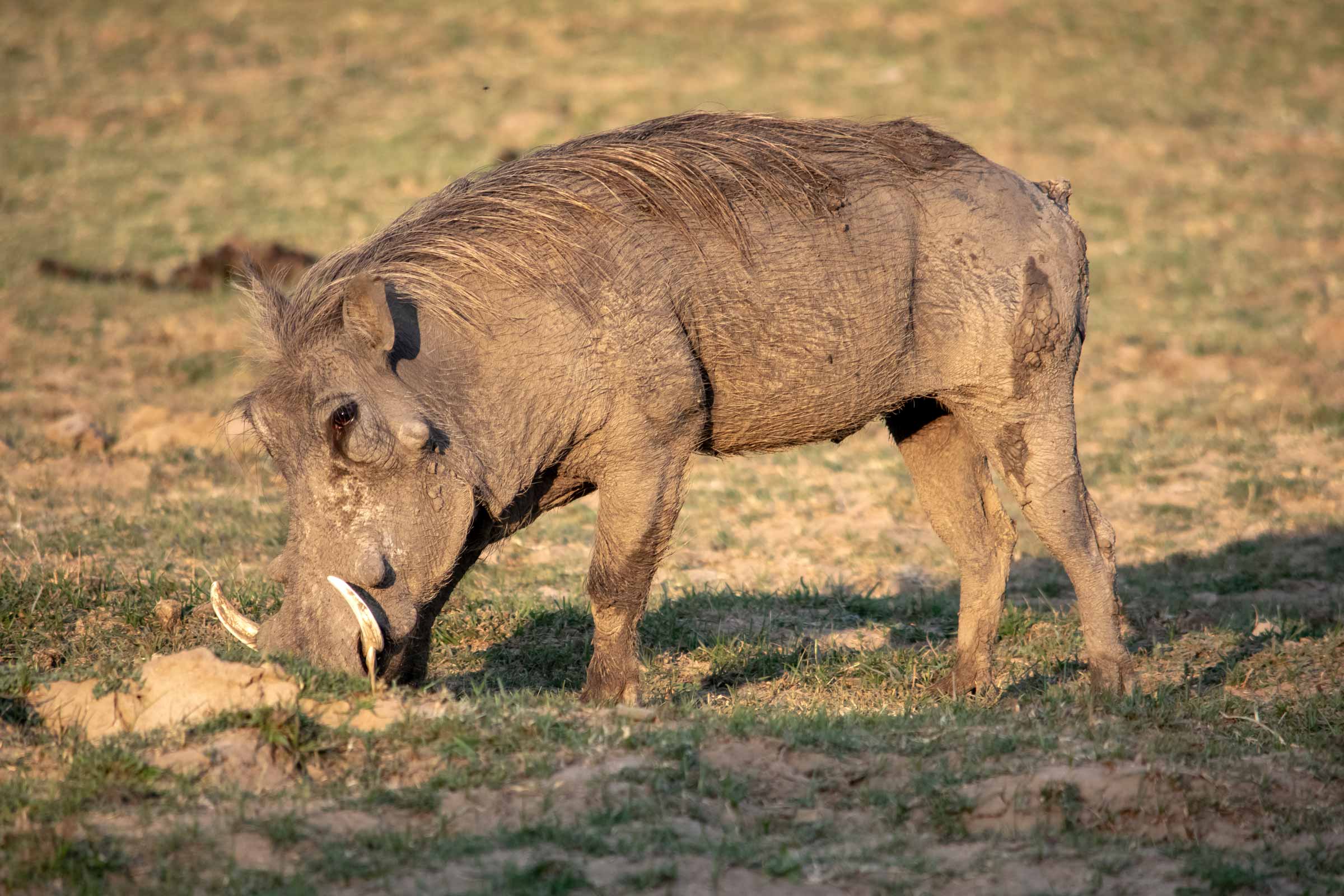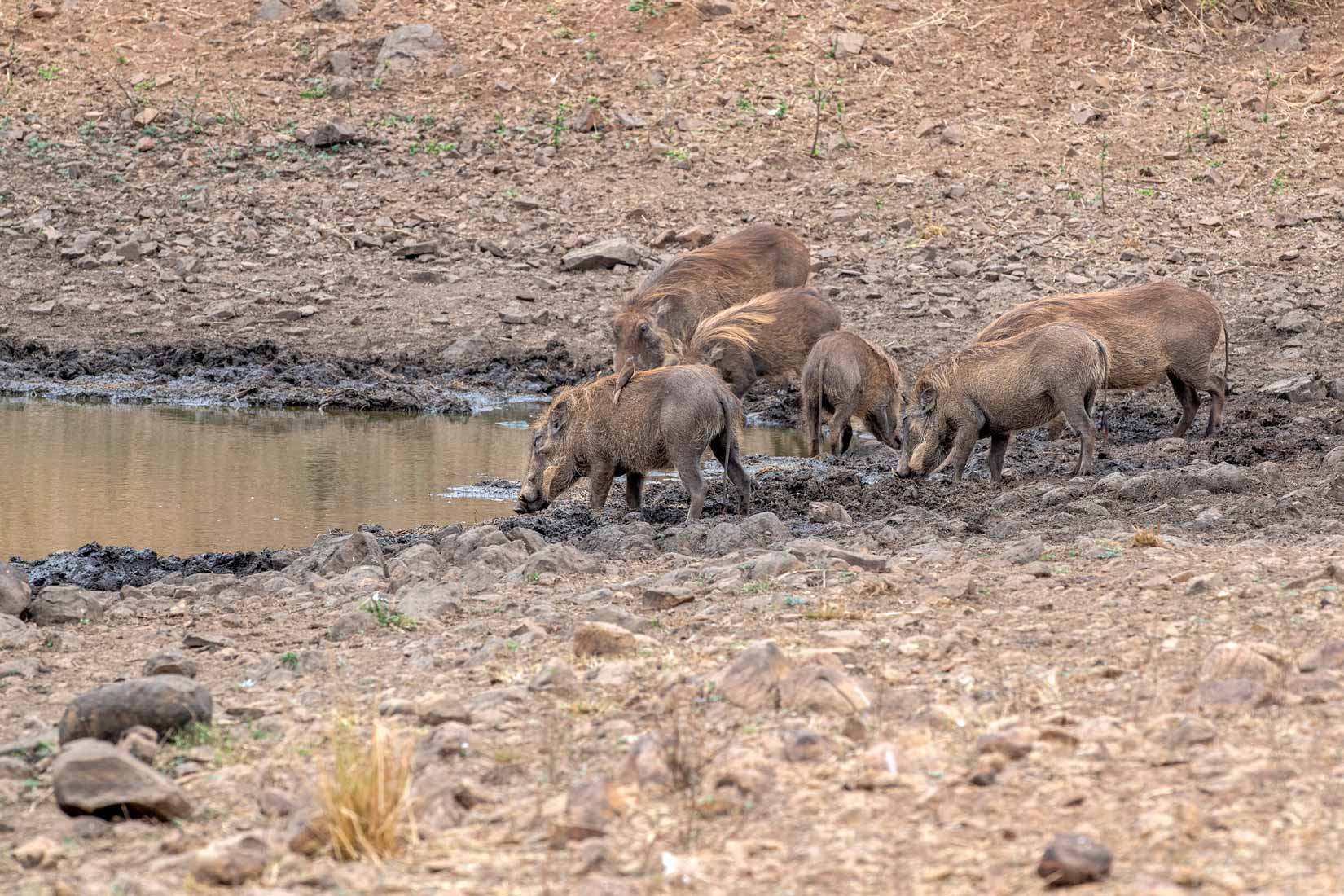African Warthog
Warthogs belong to the family Suidae, which also includes domestic pigs, wild boars, and other pig-like animals. There are two species within the Phacochoerus genus, the common warthog (Phacochoerus africanus) and the desert warthog (Phacochoerus aethiopicus). For the purpose of this article, we focus on the common African warthog.

Overview
The African warthog (Phacochoerus africanus) is a fascinating creature, often recognized for its rugged appearance and quirky behavior. This wild member of the pig family is a common sight on the African savannas, standing out due to its large tusks and the distinctive warts on its face. Though not as celebrated as Africa’s big cats or massive elephants, the warthog is a resilient survivor, having adapted brilliantly to some of the continent’s most challenging environments.
From the dry, sparse savannas to the open grasslands of sub-Saharan Africa, warthogs thrive in regions that would prove difficult for many other species. This adaptability, combined with their unique physical characteristics and resourceful behavior, makes them a remarkable component of Africa’s diverse wildlife. Let’s dive deeper into the world of the African warthog, an animal that represents the hardy spirit of survival in the African wilderness.
Scientific Classification
- Kingdom: Animalia
- Phylum: Chordata
- Class: Mammalia
- Order: Artiodactyla
- Family: Suidae
- Genus: Phacochoerus
- Species: Phacochoerus africanus
Description
Physical Characteristics
The African warthog is a medium-sized mammal, with males generally larger than females. A fully grown warthog stands about 65 to 85 cm tall at the shoulder and can weigh between 50 to 150 kilograms, depending on the region and available resources. Their bodies are covered in coarse, sparse hair, which is typically brown or gray, allowing them to blend into the dry grasslands and scrublands where they live.
Warthogs have large heads relative to their body size, and the most noticeable feature is the two pairs of upward-curving tusks. These tusks are modified canine teeth, with the upper pair being more prominent. The upper tusks can grow up to 25 cm long, and are used primarily for defense and digging. The lower tusks are shorter but sharp, helping the warthog in combat and feeding.
True to their name, warthogs have facial ‘warts’ – thick growths of skin that provide protection during fights. Males have larger and more noticeable warts than females, which help cushion blows during battles over territory or mates. Their bodies are built for endurance rather than speed, with sturdy legs and a large, barrel-shaped torso that allows them to forage for long periods in harsh environments.
Unique Traits
One of the warthog’s most unique and endearing traits is the way it runs. When alarmed, warthogs bolt into a run with their tails standing straight up like a flagpole, a behavior that is thought to signal danger to other members of the group.
Warthogs are also known for their exceptional digging ability. With their large tusks and strong snouts, they dig up roots, bulbs, and other vegetation from the ground, which constitutes a large portion of their diet. Additionally, they excavate burrows, often using abandoned aardvark holes for shelter. These burrows offer protection from predators and extreme weather conditions. When entering their burrows, warthogs do so rear-first, positioning themselves to face any incoming threats.

Behavior and Diet
Warthogs are diurnal, meaning they are most active during the day. They typically spend their mornings and afternoons foraging for food, while taking shelter during the heat of midday. Though they may appear aggressive due to their tusks and muscular build, warthogs are surprisingly timid and will often flee at the first sign of danger. However, when cornered or provoked, they can become formidable opponents, using their tusks to defend themselves against predators such as lions, leopards, and hyenas.
Diet
Warthogs are omnivorous, though their diet leans heavily towards plant matter. They are primarily grazers, feeding on grasses, roots, bulbs, and berries. During the dry season, when green vegetation is scarce, they rely on digging up tubers and bulbs from the earth. Warthogs also engage in a behavior known as geophagy, where they consume soil to supplement minerals, such as salt, that may be lacking in their diet.
Though predominantly herbivorous, warthogs will occasionally consume small animals, carrion, and insects, particularly during times of food scarcity. Their adaptability in terms of diet allows them to survive in a variety of habitats, including those that undergo seasonal changes in vegetation availability.
Reproduction and Lifespan
Warthogs have a polygynous mating system, where dominant males compete for the opportunity to mate with several females. Mating typically occurs during the rainy season when food is abundant. After a gestation period of approximately 175 days, females give birth to a litter of two to four piglets.
The birthing process takes place in the safety of a burrow, where the piglets remain for the first several weeks of their lives. During this time, the mother is fiercely protective, often defending her offspring against potential threats. Warthog piglets are weaned at around four months of age but may remain with their mothers for up to two years, forming small family groups called sounders. These sounders usually consist of females and their young, while males are more solitary or form bachelor groups.
In the wild, warthogs have a lifespan of about 12 to 15 years, though some individuals may live longer in the absence of predators or other threats.
Habitat and Geographical Distribution
The African warthog is widely distributed across sub-Saharan Africa, inhabiting a variety of ecosystems. They can be found in the savannas, grasslands, woodlands, and even in semi-arid regions. However, warthogs are most commonly associated with open plains and savannas, where they graze alongside other herbivores such as zebras and antelopes.
Countries where warthogs are commonly found include:
- Kenya: In areas like the Masai Mara, warthogs are a common sight.
- Tanzania: The Serengeti and Ngorongoro Crater provide ideal grazing grounds for these animals.
- South Africa: Warthogs roam freely in Kruger National Park.
- Botswana: They are abundant in the Okavango Delta and Chobe National Park.
- Zimbabwe: Found in Hwange National Park and other regions.
- Uganda: In the grassy expanses of Murchison Falls and Queen Elizabeth National Parks.
Warthogs are typically absent from dense forests and deserts, as they require access to water and open spaces for grazing. Their preference for open habitats and proximity to water sources often places them in competition with other herbivores, though their ability to dig for food gives them an edge during the dry season.
Conservation
The African warthog is currently listed as “Least Concern” on the IUCN Red List of Threatened Species, meaning they are not considered at immediate risk of extinction. However, warthogs do face certain challenges, including habitat loss due to agricultural expansion, human-wildlife conflict, and hunting in some regions. Despite these pressures, warthogs have remained relatively stable across much of their range, thanks to their adaptability and ability to thrive in human-modified landscapes.
Conservation efforts for warthogs are often intertwined with broader initiatives to protect African savannas and grasslands, which benefit numerous species. Protected areas like national parks and game reserves play a crucial role in ensuring warthogs have safe habitats where they can thrive.
Additionally, education and ecotourism efforts help to reduce negative interactions between humans and warthogs. By raising awareness about the importance of preserving natural ecosystems, these initiatives contribute to the long-term survival of the species.
Facts
Interesting facts about The African warthog (Phacochoerus africanus).
Warthogs can run up to 48 km/h when threatened, making them surprisingly fast for their size.
The large warts on a warthog’s face are not just decorative; they protect the animal during fights with rivals or predators by cushioning blows.
Warthogs raise their tails like flagpoles when running, which makes them easier to spot in tall grass for other members of their group.
Warthogs often graze on their knees, using specialized pads to protect their joints from the rough ground while feeding.
Warthogs enter their burrows backward, facing outward, so they are ready to confront any incoming threats head-on.
Yes, despite living in arid areas, warthogs are excellent swimmers and enjoy wallowing in mud to cool off and protect their skin from insects.
Warthogs allow birds like oxpeckers and mongooses to pick ticks and parasites off their skin, benefiting both the warthog and these animals in a win-win relationship.
While females and young warthogs form social groups called sounders, adult males tend to lead more solitary lives or form small bachelor groups.
When threatened, warthogs can either use their sharp tusks to fight off predators or escape into their burrows for safety.
Yes, warthogs are highly adaptable and can consume animal matter, such as insects or small mammals, during lean times when plant-based food is scarce.
Other Animals
Explore fauna in Africa.






